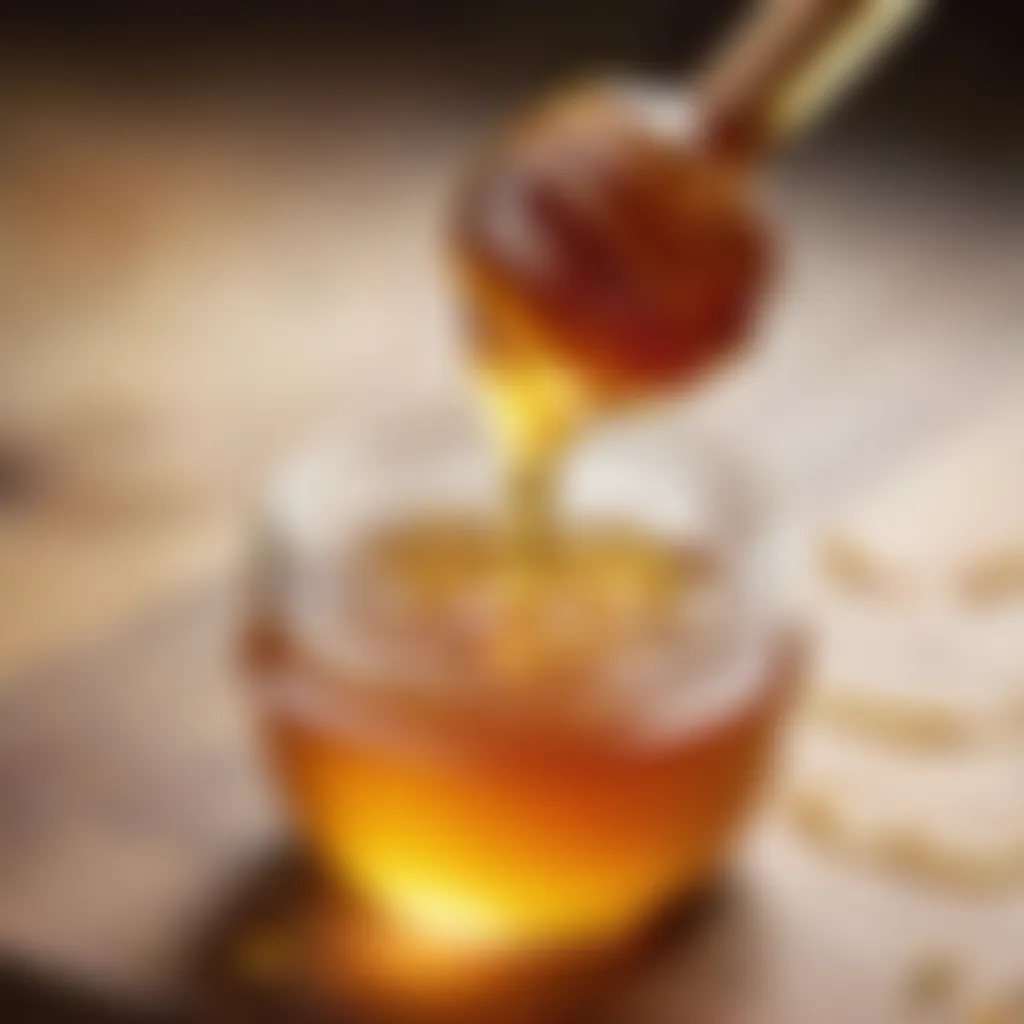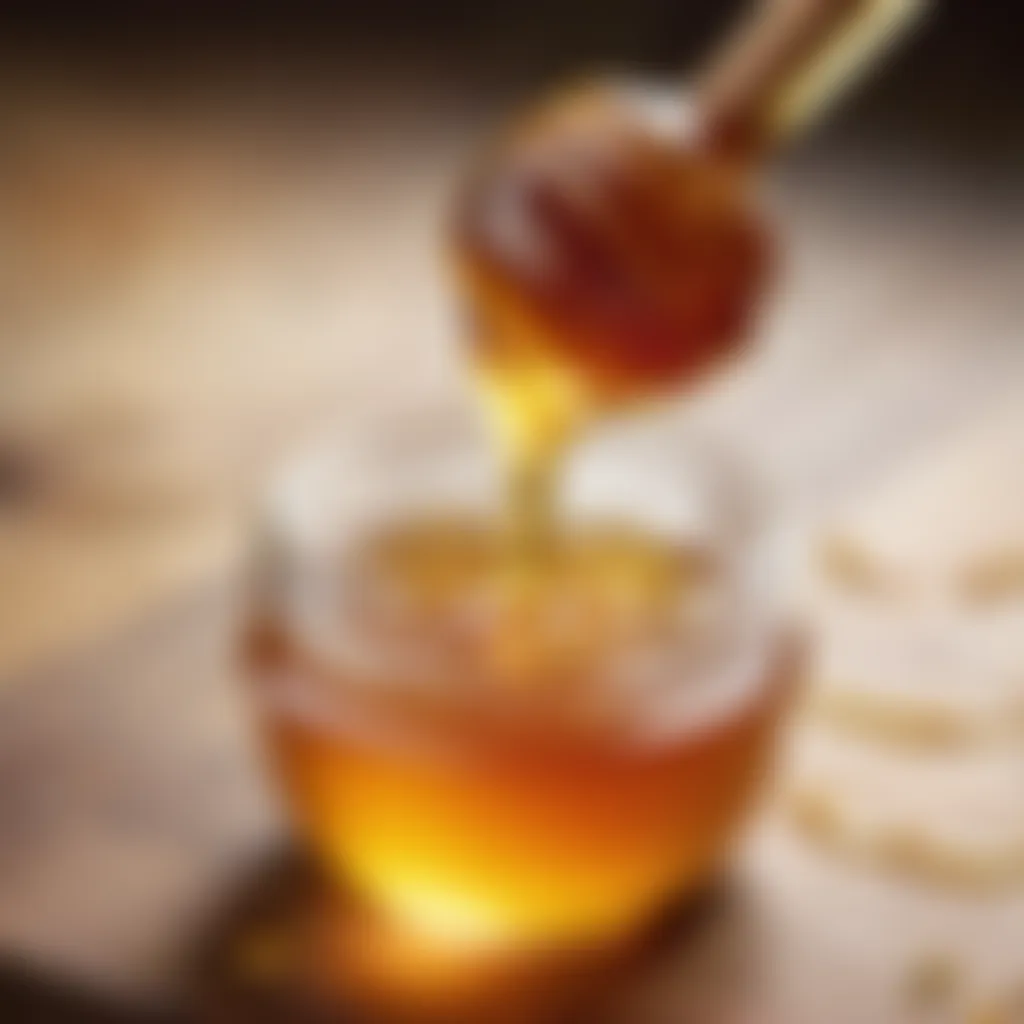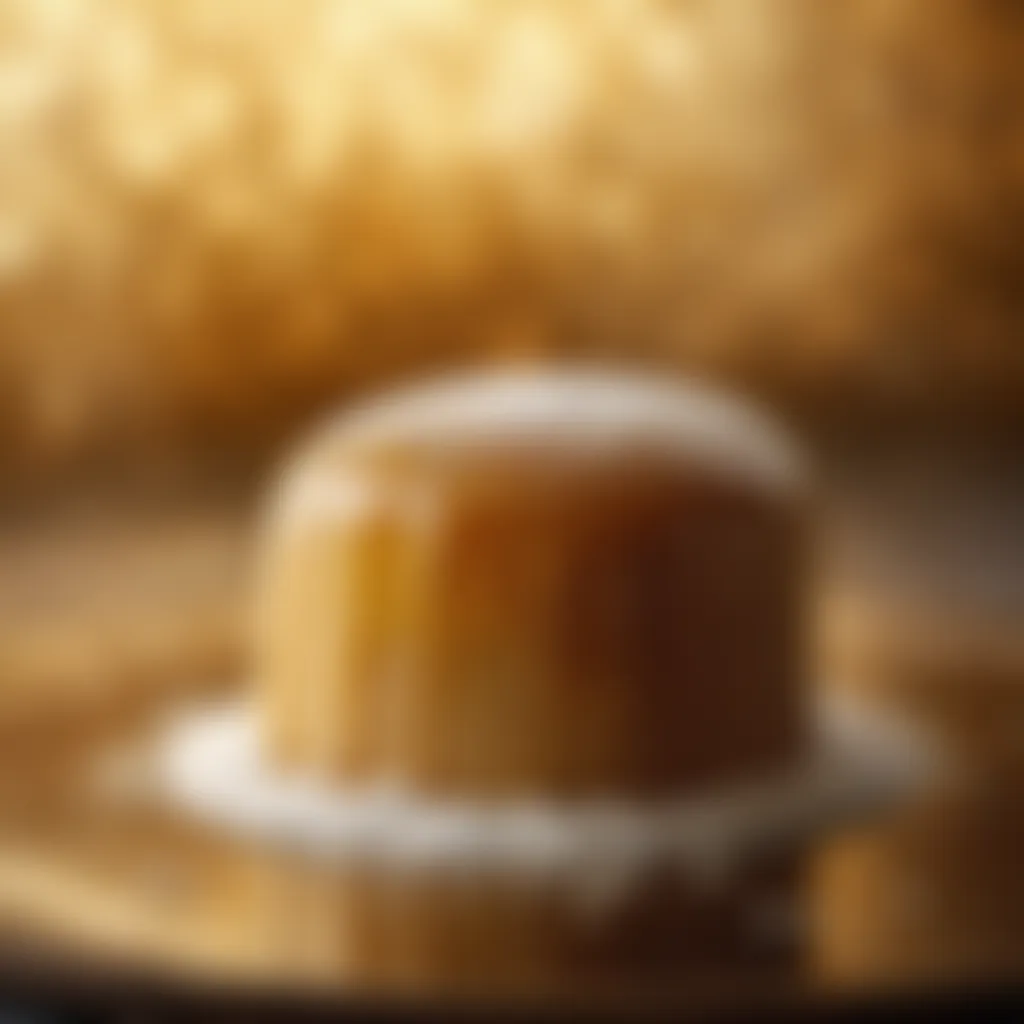Crafting Hydromel: A Comprehensive Guide to Mead Making


Intro
Making hydromel, often celebrated as the first fermented beverage, is an age-old craft that has enthralled enthusiasts for centuries. With its deep roots in ancient cultures, hydromel combines honey, water, and sometimes various fruits or spices to create a delightful drink that can range from sweet to dry. Whether you’re a novice looking to dabble in fermentation or a seasoned enthusiast eager to enhance your skills, this guide aims to walk you through every essential step to create your own bottle of hydromel at home.
Ingredients:
To embark on this flavorful journey, gather the following ingredients. The measurements provided here yield approximately one gallon of hydromel, which should be ample for sharing with friends or simply enjoying over quiet evenings.
- Honey: 3 to 4 pounds (choose a quality honey with no impurities)
- Water: 1 gallon (filtered is preferable)
- Yeast: 1 packet of mead yeast or champagne yeast
- Acid blend: 1 teaspoon (optional, enhances flavor)
- Nutrient: 1 teaspoon (promotes healthy fermentation)
- Fruits or spices: Optional, but can include raspberries, ginger, or cinnamon sticks (experiment according to your taste)
Preparation Steps:
The preparation of hydromel is truly an art that requires attention to detail and a bit of patience. Below is a step-by-step process to ensure clarity and precision:
- Sanitize Your Equipment: Before you start, it’s crucial to sanitize all equipment. This may include your fermentation vessel, stirring spoon, and airlock. Using a solution of star san or a similar sanitizer is recommended.
- Mix the Honey and Water: In a large pot, heat about half of the water but do not boil it. Stir in the honey until it is fully dissolved. Then, add the remaining cool water to bring down the temperature of the mixture.
- Cool the Mixture: It’s important that the honey-water mixture cools to room temperature before you add the yeast. This often takes about 30-60 minutes.
- Add Yeast and Nutrients: Once cooled, sprinkle the yeast on top of the mixture and, if you’re using it, stir in the acid blend and nutrient. Allow it to sit for about 15 minutes before stirring gently.
- Transfer to Fermentation Vessel: Pour the mixture into your fermenting jug or carboy, leaving some space at the top for expansion during fermentation.
- Install the Airlock: Fill the airlock with water to the recommended level and securely fit it to your fermentation vessel. This will allow gas to escape while keeping out contaminants.
Technical Aspects:
Attention to technical details can drastically affect your final product. Keep these aspects in mind:
- Temperature: Maintain a fermentation temperature between 65°F to 75°F for optimal yeast activity.
- Timing: Primary fermentation usually takes about 2 to 4 weeks, depending on temperature and yeast activity.
- Hydrometer Reading: If you have a hydrometer, take a reading before fermentation starts and another once fermentation is complete to track the alcohol content.
Cooking Process:
The cooking process for hydromel is often straightforward yet requires close monitoring of several stages:
- Primary Fermentation: After sealing your vessel with an airlock, shake it gently daily to mix and aerate the brew. Monitor the bubbling in the airlock to observe fermentation activity.
- Secondary Fermentation: After 2-4 weeks, when bubbling slows significantly, it's time to transfer your hydromel to a new container, leaving the sediment behind.
- Aging: Allow your hydromel to age for anywhere between 1 month to a year; the flavors will deepen and mature during this phase.
- Bottling: Once satisfied with the taste and clarity, it’s time to bottle. Use sanitized bottles to avoid spoilage. \n
Troubleshooting Tips:
While making hydromel can be rewarding, it comes with its own set of challenges. Here are some common issues and solutions:
- Slow Fermentation: If fermentation appears sluggish, ensure your mixture is at the appropriate temperature and consider adding more nutrient.
- Off Flavors: This may come from poor sanitation. Always sanitize your equipment thoroughly before use.
- Too Sweet: If your hydromel remains too sweet, it might be worth trying a different yeast strain next time or extending the fermentation period.
"Experimentation is part of the fun in brewing. With every batch, you learn something new and unique."
The joy of crafting hydromel lies not just in the drink itself but also in the process, taking you on a flavorful journey steeped in tradition. So gather your ingredients and dive into this ancient art, customizing it to your heart's content.
Prolusion to Hydromel
Hydromel, often referred to as mead, is a fascinating and ancient beverage that boasts a rich tapestry of history and cultural significance. Understanding this introductory phase sets the stage for appreciating the craft behind hydromel making. At its core, hydromel is created from the simple combination of honey, water, and yeast. However, the artistry involved transcends those basic ingredients, allowing for an astonishing array of flavors and styles that can be achieved through various techniques.
The beauty of hydromel lies not just in the process of its creation but in the deep-rooted traditions it embodies. For those embarking on the journey of making hydromel, know that you are stepping into a world where the past informs the present, crafting a drink that has been enjoyed since ancient times.
Moreover, hydromel serves as an engaging medium for exploration. By delving into its historical significance and cultural context, you'll gain an appreciation that goes beyond mere fermentation. The benefits of understanding these elements enrich your experience; you won't just be brewing a beverage, but participating in a legacy and customizing it to your unique tastes.
One might take away a few key considerations when approaching hydromel:
- It is not merely a recipe but a cultural artifact.
- Local honey can add unique flavors that connect your brew to a specific place.
- Knowledge of the fermentation process opens up avenues for experimentation with flavor.
With these layers in mind, let’s venture deeper into the roots of hydromel through its historical significance.
Historical Significance
The history of hydromel is as old as time itself. Archival records indicate that this delightful beverage dates back at least 4000 years, with evidence of its production found in regions such as ancient Egypt, Greece, and even parts of Asia. It was often associated with divine offerings and royal festivities. One could argue that hydromel served both as a drink for the gods and a source of social connectivity among those who consumed it.
In the early European societies, hydromel was integral to marriage ceremonies and was often referred to as the 'drink of love.' Additionally, early Celtic and Norse cultures had their own rituals regarding hydromel, symbolizing not only sustenance but an enhancement of spiritual bonds. Interestingly, the etymology of the word "mead" hints at its honeyed origins; it traces back to the Old English term "medu."
This historical lineage adds a layer of profundity to modern hydromel-making; understanding this craft involves recognizing its ancient roots and the conversations crossing through time.
Cultural Context
The cultural significance of hydromel is multifaceted, varying from region to region. For instance, in medieval Europe, hydromel was celebrated not only as a drink but also as a crucial part of various feasts and gatherings. The rituals surrounding hydromel were often elaborate, embodying communal joy and the essence of fellowship.
Across different cultures, the methods of producing hydromel have adapted to local palates and available ingredients. For instance, in some African cultures, it has been flavored with spices and local fruits. In contrast, East Asian variations might feature herbal notes, reflecting the incorporation of regional flavors into this versatile drink.
It's important to recognize that hydromel is not just a beverage; it is a narrative of human experience, creativity, and communal tradition. By understanding its cultural context, you tap into a wellspring of inspiration that can influence your own hydromel-making practices.
To sum up, the introduction to hydromel provides a rich landscape of historical and cultural insights that can deeply enhance your brewing experience. By learning about the past, you can create not just a drink from honey and water, but a flavorful echo of centuries of human creativity.
Key Ingredients
When it comes to crafting hydromel, or mead as it’s often referred to, the foundation lies in the ingredients. Selecting the right components isn't just a matter of taste; it's an art that can elevate your brew from mediocre to something truly remarkable. Here, we dive into the nuances of the key ingredients that play an essential role in the flavor and character of hydromel.
Honey Varieties
Honey is the heartbeat of hydromel. The type of honey you choose not only determines the sweetness but also contributes unique flavors that can range from floral to earthy.


- Wildflower Honey: This is a versatile option with a light, flowery taste. It works well for beginners and pairs beautifully with fruits in your hydromel.
- Clover Honey: It has a milder flavor that acts as a blank canvas. It's especially popular among novice hydromel makers for its balanced profile.
- Buckwheat Honey: Dark and robust, this variety imparts a richer flavor. It’s suitable if you desire a hydromel with deeper notes.
Selecting the right honey boils down to personal preference, but always consider the source. Local, raw honey often retains beneficial properties and flavors lost in commercial processing.
Water Quality
Water, often underestimated in the brewing process, is actually the second primary ingredient in hydromel. The quality of water can heavily influence the final taste. Here are a few considerations:
- Purity: Always opt for filtered or spring water. Chlorine and other chemicals found in tap water can hinder fermentation and disturb the honey's natural flavors.
- Mineral Content: Water rich in minerals, like calcium and magnesium, can improve yeast health. This is crucial for a successful fermentation process.
- Temperature: It might sound simplistic, but room temperature water is ideal for mixing your honey and initiating fermentation without shocking the yeast.
Yeast Selection
The choice of yeast can be as critical as the honey and water. Yeasts come in various strains, each imparting different aromas and tastes.
- Wine Yeast: Strains like Lalvin 71B or EC-1118 are popular for hydromels. They can enhance fruity notes and are relatively forgiving for beginners.
- Ale Yeast: If you seek a more experimental brew, the use of ale yeast can contribute to a unique flavor profile.
- Wild Yeasts: For the adventurous, consider wild fermentation. Though unpredictable, it can yield astonishing results, showcasing complex flavors that reflect the local environment.
"Crafting hydromel is not just making a drink; it's curating a story told through the ingredients you select."
Find more about raw honey, its benefits and qualities here.
Explore different water sources and their impact here.
Necessary Equipment
Creating hydromel, or mead, requires attention to detail and the right tools. From the mixing pot to the bottles, each piece of equipment plays a vital role in achieving a successful fermentation process. Having the right equipment isn’t just about convenience; it can significantly affect the quality of the final product. Let’s break down what you’ll need.
Fermentation Vessels
The fermentation vessel is where the magic happens. This is the container that holds your mixture as the yeast transforms sugars into alcohol. It’s crucial to choose the right type of vessel to ensure proper fermentation. Common choices include:
- Glass carboys: These are popular among home brewers. They’re non-reactive, which means they won’t interfere with the flavors of your hydromel. Plus, they allow you to visually monitor the fermentation process, making them quite appealing.
- Food-grade plastic fermenters: Often lighter and less prone to breakage than glass, these vessels are also a solid choice. Ensure that they're from a reputable source to avoid any unwanted chemicals leaching into your brew.
Regardless of your choice, ensure your fermentation vessel has an airlock. This component allows carbon dioxide to escape while preventing outside air from entering. This step is essential for maintaining the right atmosphere for the yeast to thrive.
Measuring Tools
Accuracy is key when it comes to hydromel making. Relying on precise measurements can be the difference between a delightful drink and a disaster. Here are some must-have measuring tools:
- Digital scale: For weighing your honey, a digital scale is invaluable. Honey is denser than water, so the right weight ensures your hydromel isn’t too sweet or too dry.
- Measuring cups and spoons: Essential for measuring smaller quantities, especially when dealing with yeast or additional flavorings.
- Hydrometer: This clever tool measures the specific gravity of your mixture before and after fermentation. Understanding the initial and final gravity helps calculate the alcohol content of your hydromel, giving you a better idea of what you’re working with.
Bottling Supplies
Once you’ve created your hydromel, you’ll need the right supplies for bottling it up. Choosing how you store your glorious creation is just as important as each previous step.
- Bottles: Glass bottles are preferable for storing hydromel, as they won’t react with the liquid. Swing-top bottles and corked options both work well. Ensure they’re clean and sanitized before filling.
- Caps and corks: Depending on your choice of bottles, you’ll need to secure them properly. For corked bottles, make sure to buy high-quality corks that are sized right for your bottles to ensure a good seal.
- Funnel: A funnel can save you from a sticky mess when transferring hydromel from the fermentation vessel to the bottles. A wide-mouthed funnel will make things much easier.
Remember, cleanliness is next to godliness, especially in fermentation. Ensure that all your equipment is sanitized before and after use to prevent any unwanted flavors or bacteria from ruining your work.
Getting each piece of equipment right is essential for a successful hydromel-making journey. With the right tools, you’ll be well on your way to brewing a delightful batch that you can enjoy and perhaps even share with family and friends.
Preparation Process
The preparation process forms the bedrock of hydromel making. It is in this stage that the quality and character of the final product begin to take shape. Knowing how to mix your ingredients, apply the right amount of heat, and cool your must can greatly influence both flavor and fermentation success. This is where the alchemy of flavors originates, and mastering this section can elevate your hydromel from a simple drink to a true artisan craft.
Mixing Ingredients
Mixing ingredients is a crucial step in creating hydromel. At this point, you’re combining honey, water, and yeast together into what is traditionally known as "must." Choosing the right ratio of honey to water lays down the foundational sweetness of your brew. A popular guideline is a ratio of three parts honey to four parts water.
- Selecting Honey: The selection of honey can play a pivotal role in the outcome. Stronger, floral honeys like orange blossom or buckwheat may provide depth, whereas lighter honeys like clover will yield a more subtle, refined taste.
- Quality of Water: The quality of the water is equally paramount. If your tap water leaves a taste on its own, you might want to consider using bottled or filtered water to ensure it does not interfere with the flavors of the honey.
- Yeast Type: Selecting a yeast strain compatible with your base ingredient will make a difference in flavor profiles. Different yeasts can impart various characteristics, from floral notes to citrus flavors. Consider what flavor you want to end up with!
"The magic happens when all three ingredients meet, creating a blend that speaks to one’s palate."
Initial Heating
The initial heating step is not merely about dissolving honey into water; it serves to pasteurize the mixture, mitigating unwanted wild yeasts and bacteria. Heating the must to approximately 160°F (70°C) is a common practice. This allows for the homogeneity of the mix, ensuring all sugars are dissolved thoroughly.
Points to remember when heating:
- Never allow the must to boil as it can alter the delicate flavors of the honey.
- Stir continuously to avoid scorching the honey at the bottom. A gentle approach goes a long way here.
- This is the moment when some hydromel makers might choose to add spices or fruit extracts, but care must be taken to gauge how these will interact with your final product.
Cooling the Must
After the heating phase, you need to cool the must down to an appropriate temperature that is conducive for the yeast. A temperature around 70°F (21°C) is generally ideal for introducing your yeast. Cooling can be done by placing your fermentation vessel in an ice bath or simply letting it sit in a cooler area.
Keep these pointers in mind during cooling:
- Make sure to cover the fermentation vessel with a sanitized lid or cloth. This will protect your must from contaminants.
- Temperature control is crucial as yeast can become dormant if too cold, and overly warm conditions can stress them or even kill them.
- Taking your time in this step yields better results; rushing might put your fermentation at stake.


Fermentation Techniques
Fermentation serves as the backbone of hydromel production, embodying a fascinating transformation where sweet ingredients morph into a vibrant drink laden with complexity and character. Understanding fermentation techniques not only ensures the successful conversion of sugars into alcohol but also significantly affects the flavor profile, aroma, and overall quality of the final product. This section unpacks the essential methods involved in fermentation, presenting a clear roadmap for both novice and seasoned makers alike.
Primary Fermentation
Primary fermentation is where the magic starts to happen. Once the must—your mixture of honey, water, and yeast—is prepared, it’s time to kick things into gear. The yeast, which acts as your fermentation agent, initiates the process by consuming the sugars in the must and converting them into alcohol and carbon dioxide. This phase typically lasts from a few days to several weeks, depending on various factors including the type of yeast used and environmental conditions.
During this time, it’s crucial to keep an eye on the fermentation vessel. Look for signs like bubbling or foaming, which indicate active fermentation. The vessel should be equipped with an airlock to allow gases to escape while preventing any unwanted contaminants from entering. If things are ticking along nicely, you should notice a pleasant, fruity smell developing.
Secondary Fermentation
Once primary fermentation has run its course, the next step is secondary fermentation. This phase is vital for refining and clarifying your hydromel. The process usually involves transferring the fermented liquid—now often called “young hydromel”—to a clean fermentation vessel, leaving behind the sediment (called lees) that has built up at the bottom.
Secondary fermentation can enhance the complexity of your hydromel. At this stage, you can also introduce flavors. Fruits, spices, or other botanicals can be added, allowing for a wide range of taste profiles. It usually lasts an additional few weeks to a few months, during which the flavors meld and mature. Be sure to taste along the way; it’s an excellent opportunity to assess and adjust.
Temperature Control
Temperature control is a linchpin in both fermentation phases. Yeast activities are highly sensitive to temperature fluctuations. For instance, if the must is too cold, fermentation may sluggishly crawl or even halt altogether, leading to a stuck fermentation. Conversely, excessive heat can kill the yeast or produce undesirable off-flavors.
Key considerations include:
- Ideal Temperatures: Generally, a temperature range of around 65°F to 75°F (18°C to 24°C) is considered optimal for most yeast strains.
- Monitoring: Utilize a thermometer to monitor the temperature regularly.
- Insulation: If it’s particularly chilly or warm in your brewing space, consider insulating your fermentation vessel or using a temperature-controlled environment.
A good rule of thumb is to find that sweet spot—stable temperatures lead to consistent fermentation results.
"Fermentation is both a science and an art, where meticulous attention to detail meets the freedom to create."
Mastering these fermentation techniques will pave the way for crafting a hydromel that impresses not only in taste but also in texture and aroma. Once you’ve confidently navigated through primary and secondary fermentation, and monitored those all-important temperature nuances, you’re well on your way to producing brilliant hydromel. Stay tuned for the next steps in the bottling and aging processes which will seal the deal for your glorious creation.
Common Variations of Hydromel
Exploring the common variations of hydromel is akin to expanding one's culinary horizons. Each iteration not only showcases the versatility of this ancient beverage but also allows for personal expression in the creation process. Variations can influence flavor, aroma, and the overall drinking experience, making it essential to understand them for anyone serious about hydromel making.
Traditional Hydromel
Traditional hydromel often echoes the original recipes from centuries past, commonly using just honey, water, and yeast. The beauty of traditional hydromel lies in its simplicity. Using quality honey is paramount. It serves as both the primary flavor source and the fermentable sugar necessary for yeast to produce alcohol. For many, going for a clean, neutral honey, like clover or wildflower, is advisable.
However, those looking to add a unique twist should consider local honey options. Depending on the region’s flora, Avocado or Orange Blossom honey can bring vibrant, distinct flavors that can elevate the drink. The fermentation process here can take several weeks, achieving a light and crisp hydromel perfect for sipping or pairing with cheese and charcuterie boards.
Fruit-Infused Hydromel
Fruit-infused hydromel is where creativity truly shines. By adding fruits like berries, citrus, and even tropical varieties, brewers can create a refreshing twist on the traditional recipe. The fruit not only contributes sugars for fermentation but also infuses the hydromel with unique, colorful flavors.
- Choosing the Right Fruit: Berries like strawberries, raspberries, and blueberries are popular choices due to their natural sweetness and vibrant colors. Citrus fruits, such as lemons or limes, can add a zesty brightness. Some brewers even experiment with mango or pineapple.
- Timing is Key: Adding fruits during primary fermentation can yield robust flavors, whereas adding them later often brings out fresher notes.
- Know Your Ratios: A general rule of thumb is to use about 1 pound of fruit per gallon of hydromel to balance sweetness and acidity.
Fruit-infused varieties are especially enjoyable during warm months, making them ideal for gatherings or summer picnics.
Spiced Hydromel
If variety is the spice of life, then spiced hydromel certainly embodies that philosophy. This variation marries honey’s natural sweetness with warm, aromatic spices, producing a beverage that’s complex and inviting. Spices can range from the familiar such as cinnamon and ginger to the more exotic, like cardamom or star anise.
- Experiment with Combinations: Mixing different spices can create unique profiles. A blend of cinnamon and cloves can evoke cozy autumn feelings, while ginger and cardamom can remind sippers of a winter holiday.
- The Right Amount: A cautious hand is essential. Start with small amounts—like a teaspoon per gallon—and taste along the way, adjusting as desired.
- Aging: Spiced hydromel often benefits from aging, allowing flavors to meld together seamlessly. This can enhance the overall complexity, creating a truly warming and delightful drink.
Ultimately, whether one opts for traditional, fruit-infused, or spiced hydromel, experimenting with these variations opens a world of flavor possibilities. Each iteration not only highlights unique ingredients but also offers an enriching journey toward mastering the craft of hydromel making.
Troubleshooting Common Issues
In the world of hydromel making, as with any culinary craft, challenges often arise that can throw a wrench in your plans. Getting a handle on these potential hiccups is crucial not just for ensuring a smooth brewing process but also for achieving that memorable taste you’re aiming for. This section delves into two prevalent challenges: fermentation problems and off-flavors. Recognizing these issues early on, and knowing how to fix them, can make a significant difference in the final outcome of your hydromel.
Fermentation Problems
When it comes to fermentation, it's all about the right elements falling into place. If things go south, you might find yourself staring at a bubbling vat of disappointment rather than a glorious batch of hydromel. One of the biggest culprits for fermentation woes is temperature. Yeast behaves like Goldilocks; it wants the conditions to be just right. If your fermentation environment is too cold, the yeast might just go into hibernation, leaving your mixture stagnant. On the other hand, if it’s too hot, your yeast can die off, which isn’t exactly a recipe for success.
Here are some common fermentation issues to watch out for:
- Lack of bubbles: This might indicate that fermentation isn’t occurring. Inspect the yeast or check the temperature.
- Excessive foaming: If you’re witnessing a volcanic eruption in your fermentation vessel, it could be due to high sugar content or too much aeration during mixing.
- Specific gravity not changing: If you’ve taken a hydrometer reading and it remains stagnant, this could be a sign of inactive yeast.
To tackle these problems, here are a few strategies:
- Manage Temperatures: Use heating pads or wine coolers to get conditions just right for your yeast.
- Re-pitch Yeast: If you find that yeast is inactive, you can add more to the must to get things bubbling again.
- Patience and Observation: Sometimes, all you need is a little time and a careful eye on the process.
Off-Flavors
The last thing you want after investing your time and effort into making hydromel is to discover an unpleasant flavor lurking in your bottle. Off-flavors can leave a bad taste—not just in your mouth but in your experience as a whole. There are various reasons why your hydromel might not have that fresh, crisp taste you were aiming for.
Common causes of off-flavors include:


- Contaminated Equipment: Even a tiny speck of residue from previous brews can lead to unexpected flavors.
- Poor Yeast Health: If the yeast is stressed, it may produce unwanted byproducts, such as acetaldehyde, which can impart a green apple taste.
- Not Enough Oxygen: While too much oxygen can spoil the brew, a complete lack can cause your hydromel to taste flat.
To fend off these unwanted flavors, consider the following:
- Sanitize Everything: Keep your equipment squeaky clean before you get started. Using a suitable sanitizer makes a world of difference.
- Feed the Yeast: Ensure your yeasties have all the nutrients they need to thrive, which can help minimize off-flavors.
- Aerate Wisely: Give your must a good swirl before fermentation, but be cautious post-fermentation to avoid oxidation.
Remember: The journey of hydromel-making is as much about learning as it is about creating. Don’t let a few bumps along the road discourage you; each stumble is an opportunity to refine your craft.
By knowing how to navigate these common hiccups, you can enjoy not just a glass of hydromel, but the entire process leading up to it. Whether you find yourself on the brink of making an exquisite mead or troubleshooting for the umpteenth time, frame each experience as part of the art!
Bottling and Aging
Bottling and aging are crucial steps in the process of hydromel making, often turning the crafted liquid from a simple blend into a refined beverage. Properly executing these stages impacts not only the quality of the hydromel but also its longevity and flavor development. Each bottle is a time capsule; if seals break or conditions are off, you risk losing all the time and care put into making your hydromel. Thus, understanding this stage elevates your mead-making skills and enhances the final product.
Choosing the Right Bottles
Selecting the right bottles can make a world of difference. Think of bottles as the final home for your hydromel—it’s where it will age and mature. While shiny glass might catch the eye, the material and shape say more than you'd think.
- Material: Glass is a common choice for hydromel. It doesn't interact with the beverage's taste, keeping flavors pure. Plastic might seem convenient, but it can leach chemicals over time, altering the taste.
- Color: Dark or amber glass is preferable, as it protects your hydromel from light exposure that can destroy flavors and aroma.
- Shape: While traditional wine bottles are a classic, many home brewers like to use bottles can be corked. However, ensure you have the right corks that fit tightly, or consider using a crown cap for a snug seal, especially for carbonated varieties.
Two or three different styles can show off the diversity of your creations. Don’t shy away from a unique bottle shape; it can be an conversation starter!
Storage Conditions
Where you store your bottled hydromel matters as much as how you bottle it. Think of it this way: a beautiful garden can wilt without proper care. Here, we are aiming to keep your mead flourishing.
- Temperature: Aim for a cool, stable temperature—around 50 to 60°F is ideal. Avoid fluctuations in temperature like jumping from a warm kitchen to a cold basement; it can cause issues like corks popping or flavor degradation.
- Humidity: A moderate humidity level keeps corks from drying out and ruining your seal. If you’re in a dry area, consider using a humidity tray nearby. It doesn’t take much to maintain a balance; a simple bowl of water works wonders.
- Light: Keep your bottles in a dark place. Just like certain wines, hydromel can suffer in direct sunlight. A dark closet or a wine cellar is a good spot.
"Bottling is the last step before tasting the fruits of your labor. Make it count!"
- Positioning: Store the bottles horizontally to keep the cork moist. If you opted for crown caps, they can stand upright without issue.
Getting the bottling and aging stage right makes all the difference. A little attention here can lead to truly enjoyable hydromel that leaves a lasting impression. It’s not just about pouring into a container; it’s truly about setting up your mead for a beautiful journey ahead.
The Sensory Experience of Hydromel
The sensory experience of hydromel is more than just tasting a drink; it's about engaging the senses in a ritual that harkens back centuries. The aromas that waft from a glass of well-crafted hydromel can transport one to the fields where flowers bloom, and the honeybees dance among them. When we consider hydromel, we’re not just looking at a beverage but an adventure for the palate, an engagement between the maker and the drinker that enriches both.
Understanding how to appreciate hydromel starts with recognizing its multifaceted nature. As one might expect from a crafted drink, it’s not solely about sweetness or alcohol content; rather, it’s an intricate balance of tastes, fragrances, and textures. The experience is akin to walking through a vibrant farmer's market, where sights and smells collide to create a feast for the senses. Each sip brings with it a story, a connection to the ingredients and the place they were sourced from, making every bottle unique.
Tasting Notes
When tasting hydromel, one must approach it like a fine wine, examining its appearance, aroma, taste, and finish. The initial impression starts with the color, which can range from a pale golden hue to deeper amber tones, influenced by the types of honey and additional ingredients used.
Aroma is compelling; you might catch the scent of flowers, a hint of spices, or even the delicate swirl of fruits if they were added during the making. This olfactory experience primes your palate to what’s coming next.
As for taste, hydromel can surprise you. Depending on the recipe, you might pick up on:
- Floral notes: Elderflower or wildflower honey can lead to a fresh, crisp taste.
- Fruity undertones: Pear or peach flavors if fruits were introduced in the fermentation process.
- Spicy hints: If spices were added, hints of cinnamon or cloves can emerge as the drink warms in your glass.
The finish of hydromel is crucial too. Does it leave a sweet aftertaste or does it dry out nicely? Some hydromels linger joyfully on the palate while others may fade quickly, leaving you thirsting for another sip.
Pairing with Food
Pairing hydromel with food is an art that can elevate both the drink and the dish to new heights. The aim is to find a balance where neither overpowers the other but instead enhances the flavors.
Some excellent pairing suggestions include:
- Cheeses: Creamy brie or sharp blue cheese create a wonderful contrast, while aged cheddar can complement a richer hydromel.
- Spicy dishes: The sweetness of hydromel contrasts well against spicy cuisine, offering a relief from heat
- Desserts: It partners beautifully with fruity desserts or chocolate to round out the sweetness.
When placing your hydromel down on the table, it doesn’t just exist as a drink; it interacts with whatever you serve with it, making the entire meal feel more cohesive.
In preparing to experience hydromel, remember that it's about more than just what’s in the glass. Each bottle encapsulates craftsmanship, tradition, and a touch of personal preference. As you explore hydromel, don’t hesitate to express your own likes and dislikes, shaping your own sensory journey. Ultimately, the magic lies in discovery and enjoyment, both for the maker and the taster.
Finale
Making hydromel is more than just a recipe; it's an art that marries history with personal creativity. As we've explored, the craft is steeped in rich traditions and cultural significance, offering both a connection to the past and an avenue for personal expression. The journey from selecting the right ingredients to savoring your finished product is a labor of love. Here are a few key points to consider:
- The Craftsmanship: Each step in hydromel making reflects attention to detail, whether it is choosing the right honey or managing fermentation with care. The process fosters a sense of accomplishment and intimacy with the beverage you create.
- Health Benefits: Hydromel, particularly when made with quality honey, can offer antioxidants and antimicrobial properties. Not only do you get a delightful drink, but one that also boasts potential wellness advantages.
- Community Engagement: The hydromel community is vibrant and diverse, suggesting that joining local groups or online forums can enhance your experience. Sharing your successes or challenges offers a sense of belonging.
Reflecting on this craft illustrates how much it can enrich our lives. "A glass of honey wine is not just a drink; it can be a vessel of memories and beginnings." Creating hydromel leads to not just flavors on your palate but stories to share around the table.
Reflections on the Craft
In reflecting on the craft, it is important to appreciate how hydromel making transcends mere preparation and becomes an intimate ritual. The process nurtures mindfulness; every step, from mixing ingredients to bottling, requires focus and intent. Over time, many find personal techniques and preferences that bring their distinctive touch to the drink, fostering a sense of ownership and pride. Each batch contains a bit of the maker's essence, making every sip unique.
One can’t overlook how this craft cultivates patience. The waiting period for fermentation and maturation forces us to slow down in a fast-paced world. It’s a gentle reminder that sometimes the best things in life take time.
Future of Hydromel Making
Looking ahead, hydromel making is set to flourish as more people delve into artisanal beverages. As awareness grows about homemade drinks, the age-old craft is poised to capture the imaginations of both novice makers and seasoned connoisseurs. Additionally, experimentation with flavors and sources will become increasingly prevalent. Infusions of local fruits or spices could unveil remarkable new profiles, catering to evolving tastes.
Moreover, eco-conscious practices are likely to play an essential role. As more individuals seek sustainable options, using local honey, organic ingredients, and eco-friendly bottles could deepen the connection between us and our environment. As hydromel gains acceptance and recognition in the broader beverage landscape, there is no doubt that it will continue to evolve, adapting to both tradition and innovation.
In essence, hydromel making offers a doorway into not just a beverage but a broader relationship with food, community, and the past. Whether you're an aspiring brewer or someone who simply enjoys a good drink, now is a fantastic time to explore this satisfying craft.







